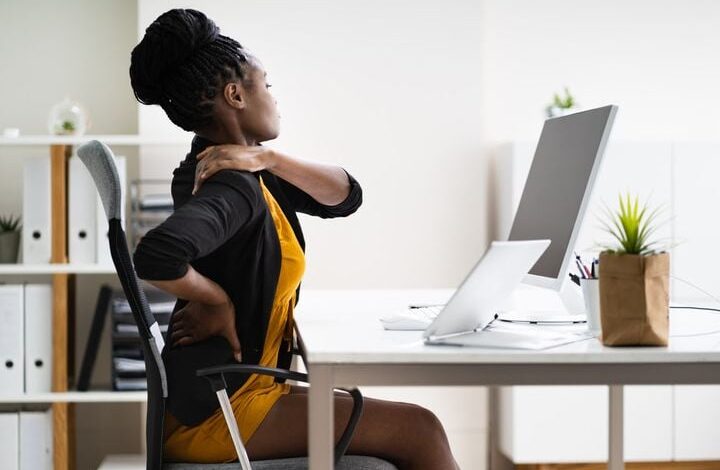Yoga Expert Reveals Quick Fix for Tech Neck – Wellness

A yoga expert has revealed her top tips to help combat ‘tech neck’, or the lower neck pain caused by the muscles we strain when staring at our phones, tablets, or computers.
Erika Weiss, a wellness expert at ISSA Yoga, says that simply changing how you hold your device makes a big difference in combating long-term posture problems – as well as catching yourself when you start to slump and practicing some key yoga moves.
The nation’s concerns around poor posture appear to have risen of late, as Google Trends shows that searches for ‘fix bad posture’ have skyrocketed 873% in the last month alone. Searches for ‘sore neck’ are also up by almost a third (30%).
According to Weiss, many of us will only realize how bad our posture has become as we start gearing up to take a break from the office and enjoy the summer sun.
She says: “Just as some people fall ill once they stop working before a holiday, others will realize that rushing to meet last-minute deadlines and internalizing their stress has had a detrimental effect on their posture, resulting in lower neck and upper back pain.”
“This is particularly true for people who spend long periods at their desk without interruption, or those who work remotely and are therefore less inclined to take restorative breaks.”
Some key signs that show your posture is starting to take a toll include frequent headaches, pain between the shoulder blades, a stiff or immovable neck – and even jaw pain.
If that sounds like you, rest assured – there are some easy ways to help during work hours, as Weiss stresses the importance of an ergonomic set-up: “One of the easiest ways to reduce discomfort caused by bad posture is to raise your devices so that they’re on eye-level.
“Try to be conscious of how straight you sit, and if you feel yourself start to slump when concentrating or struggling to read, try to catch yourself and take a break if you can. Avoid rolling your shoulders forward or outstretching your neck to look at your screen.”
This also goes for after-work activities involving devices, such as switching out a handheld games console for an eye-level computer monitor or TV to ensure you’re sitting straight.
One of the best things for people who are experiencing an increase in back or neck pain is to take up yoga, as it works to stretch and relax the muscles that become tense during the day.
However, it’s important to focus on low-impact moves that bend your spine without causing unnecessary stress to your sore muscles, as the goal is to strengthen them, not strain them.
According to Weiss, some of the common mistakes yoga newbies make is to rush into it, as she says: “Many follow the most common or most popular routines without considering their suitability, which can exacerbate back issues and cause more soreness.”
“Unless you’re experienced, it’s best to stick to the following moves that can alleviate neck and upper back pain – but make sure you don’t push yourself too much at the start.”
Neck
Standing Forward Bend
Also known as ‘Uttanasana,’this pose also stretches your hamstrings and is beneficial for relieving stress. Start in the Raised Hands Pose before sweeping your arms down on either side and folding forwards from your hips. Bring your fingertips in line with the toes, and press your palms flat. Let your head hang loosely and inhale slowly on the way back up.
Warrior II Pose
Start in the Mountain Pose and take a big step back with your left leg, toes pointing inwards. Press your feet down, and firm your legs before raising your arms outwards parallel to the floor. Make sure that you keep your shoulders down to lengthen your neck and bend your right knee so that it aligns above your ankle. Press down through your toes to promote balance and hold.
Extended Triangle Pose
To come into this pose, stand facing the long side of your mat with your feet apart. Turn your right foot out so that your toes point to the short edge of the mat, and turn your left toes in. Roll your right thigh out before extending your body and lifting your arms parallel to the floor. Point your left arm to the ceiling and ensure your neck aligns with your spine.
Upper Back Pain
Cat Pose
Also known as Marjaryasana, you should start on your hands and knees (on all fours) with knees under the hips and wrists in line with your shoulders. Spread your fingers and pull your stomach in as you exhale, bringing your waist up and rounding out your spine. Actively push against the floor to feel the stretch in your back before relaxing on the inhale to return to a neutral position.
Thread the Needle
Start on all fours and stack your hips directly above your knees, with your elbows, shoulders, and wrists in a straight line to the ground. Lift your right hand up and follow it with your gaze, and follow your right hand down as you thread it beneath your left arm. Keep your hips high and lower your chest to the ground. Hold the position for as long as you need before switching sides.
States with Bad Posture
As well as providing expert advice on reducing tech neck, researchers at ISSA Yoga & Wellness Academy also looked at keyword data to identify which states are struggling the most with poor posture – and where could benefit the most from the tips.
The research reviewed the volume behind 40 key phrases like ‘back pain relief’, ‘fix bad posture,’ and ‘neck strain’ over the last five years, scaled against each state’s population.
And it turns out that New Yorkers are most in need of intervention to combat bad posture, with the state’s most common complaint being back pain, followed by a stiff neck.
Ranked, the 10 States That Struggle the Most with Poor Posture
- New York
- Massachusetts
- New Jersey
- Connecticut
- Hawaii
- Maryland
- Rhode Island
- Delaware
- Virginia
- California
On the other end of the scale, the states that have sought out the least advice to combat posture problems were Wyoming, Montana, Idaho, South Dakota, and Alaska.
Overall, the most common searches were around reducing upper back pain, followed by a stiff pelvis and sore neck. Searches peaked in January and rose by 11% over the summer – supporting the idea that poor posture becomes more evident during a break from work.
For reprint and licensing requests for this article, Click here.




